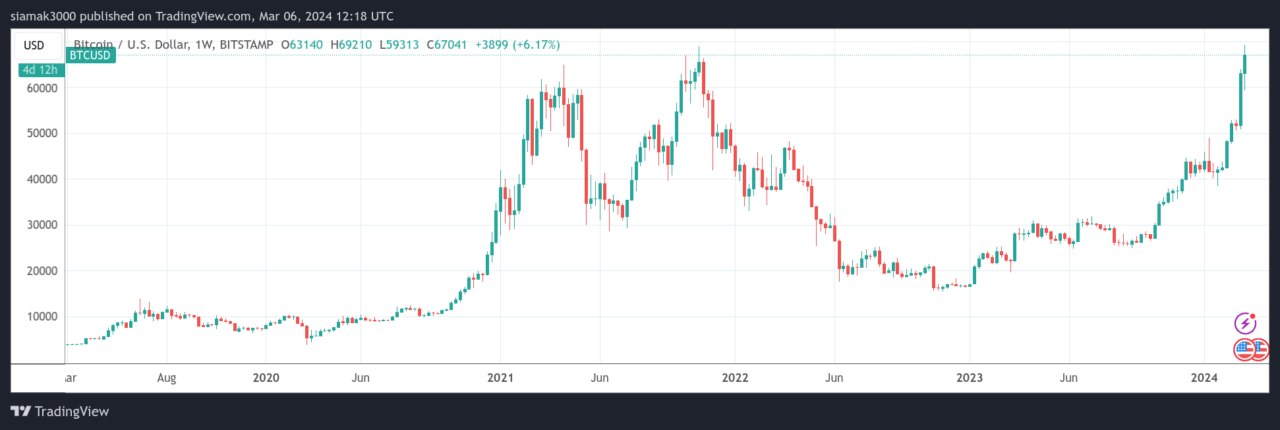On 5 March 2024, the day that the Bitcoin price reached a new all-time of $69,210 (on crypto exchange Bitstamp), CME Group released a video that examined the three key drivers behind this surge.

CME Group (Chicago Mercantile Exchange Group) is a global markets company and the world’s largest financial derivatives exchange. It was formed in 2007 through the merger of the Chicago Mercantile Exchange (CME) and the Chicago Board of Trade (CBOT). Later, it also acquired the New York Mercantile Exchange (NYMEX) and the Commodity Exchange, Inc. (COMEX). CME Group offers a wide range of futures and options contracts across various asset classes, including agriculture, energy, metals, interest rates, equities, currencies, and cryptocurrencies.
The company operates four major exchanges – CME, CBOT, NYMEX, and COMEX. CME Group’s clearing division, CME Clearing, acts as the central counterparty for all trades, ensuring the integrity of the markets and reducing the risk of default. With customers around the world, CME Group’s exchanges offer a platform for risk management and price discovery in global markets.
CME Group provides electronic trading platforms, including CME Globex, which enables market participants to trade futures, options, and other derivatives contracts. The company is known for its benchmark products, such as the E-mini S&P 500 futures, WTI Crude Oil futures, and Gold futures, among others.
In 2017, CME Group launched Bitcoin futures contracts, followed by options on Bitcoin futures in 2020, marking a significant milestone in the mainstream adoption of cryptocurrencies. CME Group plays a crucial role in the global financial ecosystem by providing a platform for trading, risk management, and price discovery across various asset classes, including commodities, financial instruments, and cryptocurrencies.
The Halving Mechanism’s Impending Impact
In this video, firstly, CME Group points to the upcoming Bitcoin halving as a significant catalyst for the cryptocurrency’s price surge. Scheduled events in the Bitcoin protocol reduce the rewards for mining new blocks, thus halving the rate at which new bitcoins are created and enter the system. This halving process, inherently designed to control inflation and mimic the scarcity of precious metals, is anticipated to constrict the supply of Bitcoin further. CME Group says that the reduced incentive to mine Bitcoin could theoretically choke its supply, putting upward pressure on its price as demand continues to grow.
Economic Concerns Fueling Bitcoin Demand
Secondly, CME Group highlights growing economic apprehensions, particularly surrounding the banking system and commercial real estate sectors, as another pivotal factor. They mention that the worries stem from the belief that the Federal Reserve’s default reaction to any financial crisis would be to reinitiate quantitative easing (QE), potentially undermining the value of the US dollar. CME Group recalls the Fed’s response to the mini banking crisis around Silicon Valley Bank in March 2023, where it promptly launched the Bank Term Funding Program to alleviate the strain, illustrating the kind of monetary policy actions that could drive investors towards Bitcoin as a hedge against dollar devaluation.
National Debt and Excessive Spending Concerns
Lastly, CME Group draws attention to the accelerating national debt and excessive government spending as critical concerns influencing Bitcoin’s valuation. With the national debt soaring to around $34.4 trillion and Federal Reserve Chair Jerome Powell labeling the trajectory as unsustainable, they mention that market sentiment appears to be tilting further in favor of Bitcoin. CME Group suggests that Bitcoin and gold are possibly reinforcing each other’s fundamental thesis, with gold’s significant gains since late 2022 (approximately 30%) potentially validating and being bolstered by the bullish outlook for Bitcoin.
Featured Image via Pixabay









